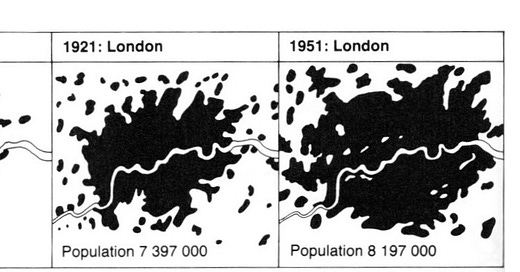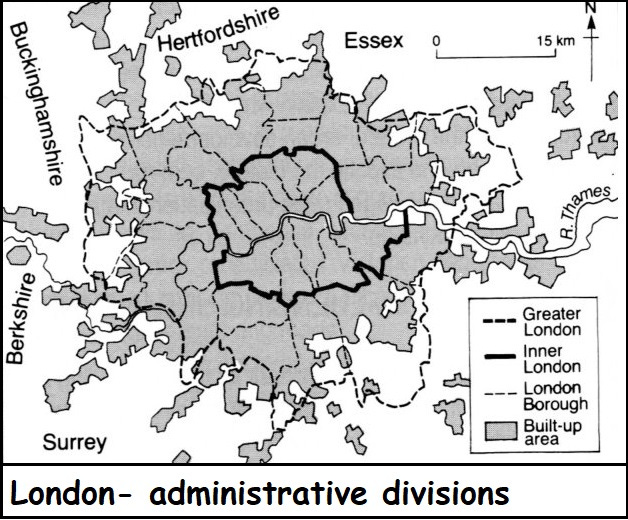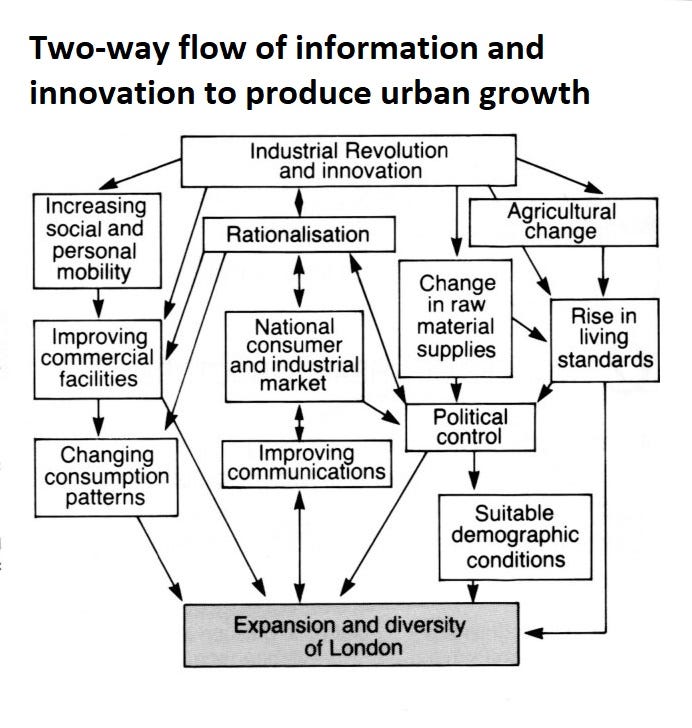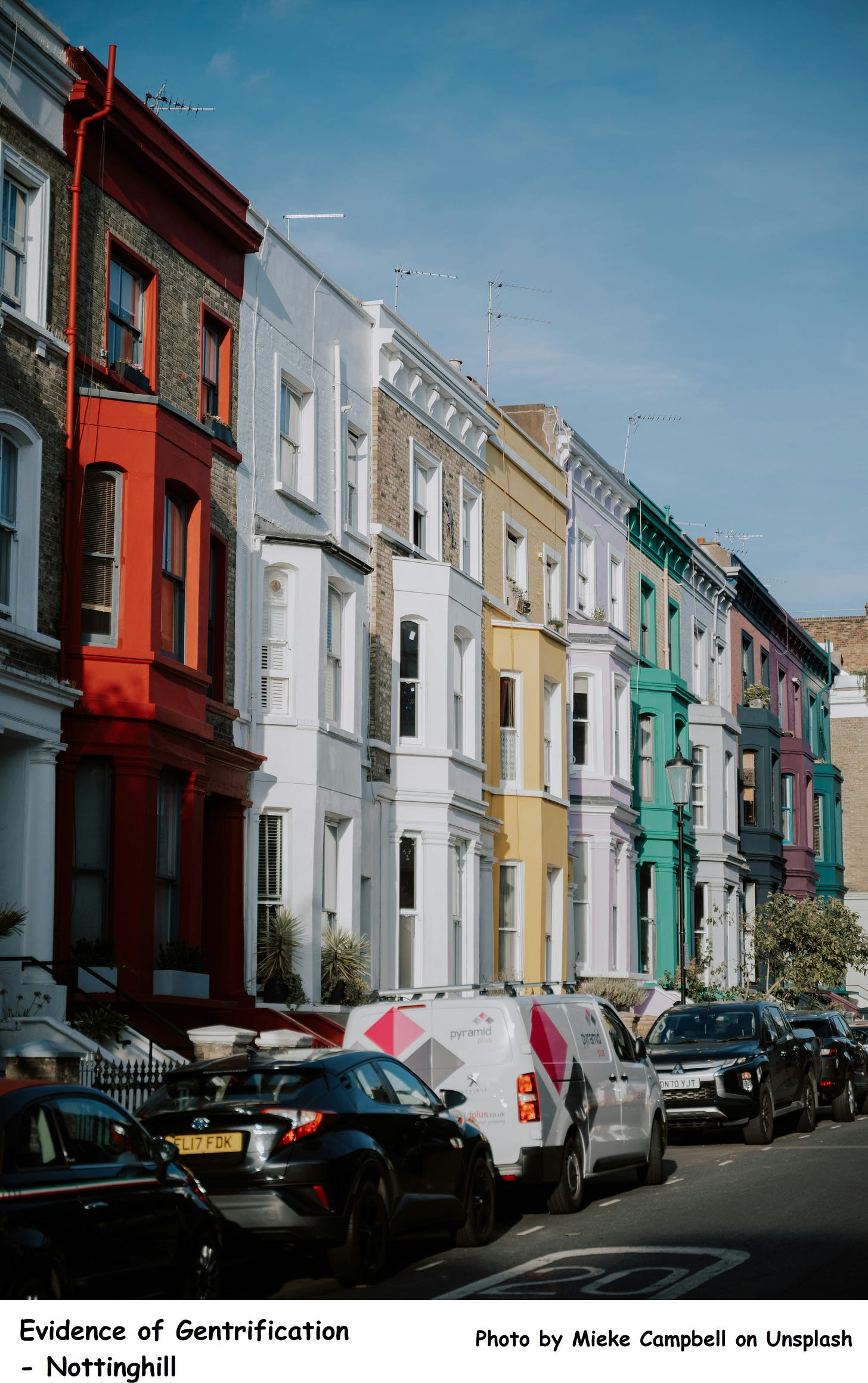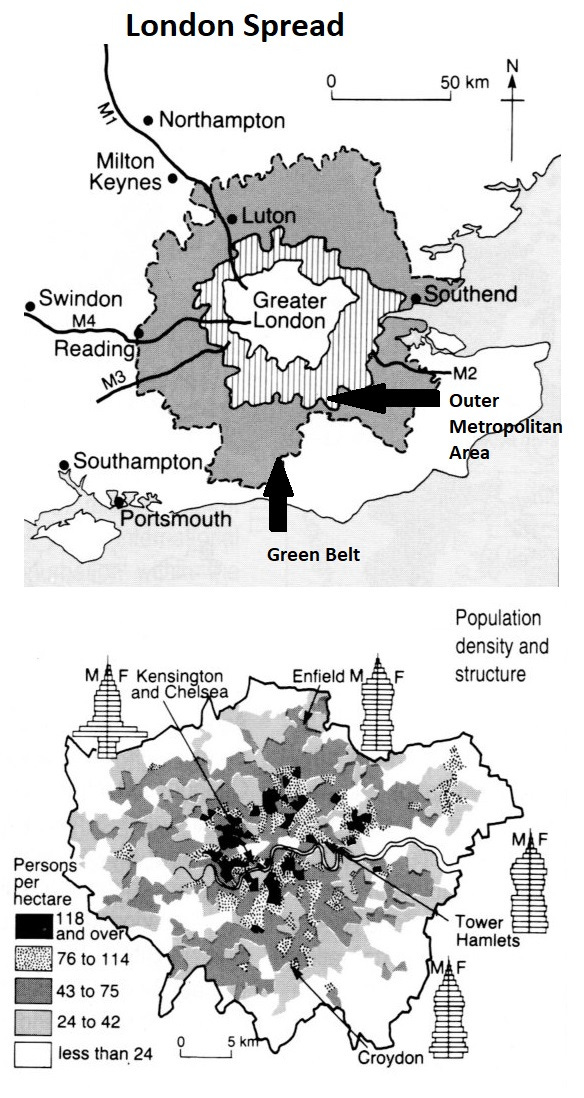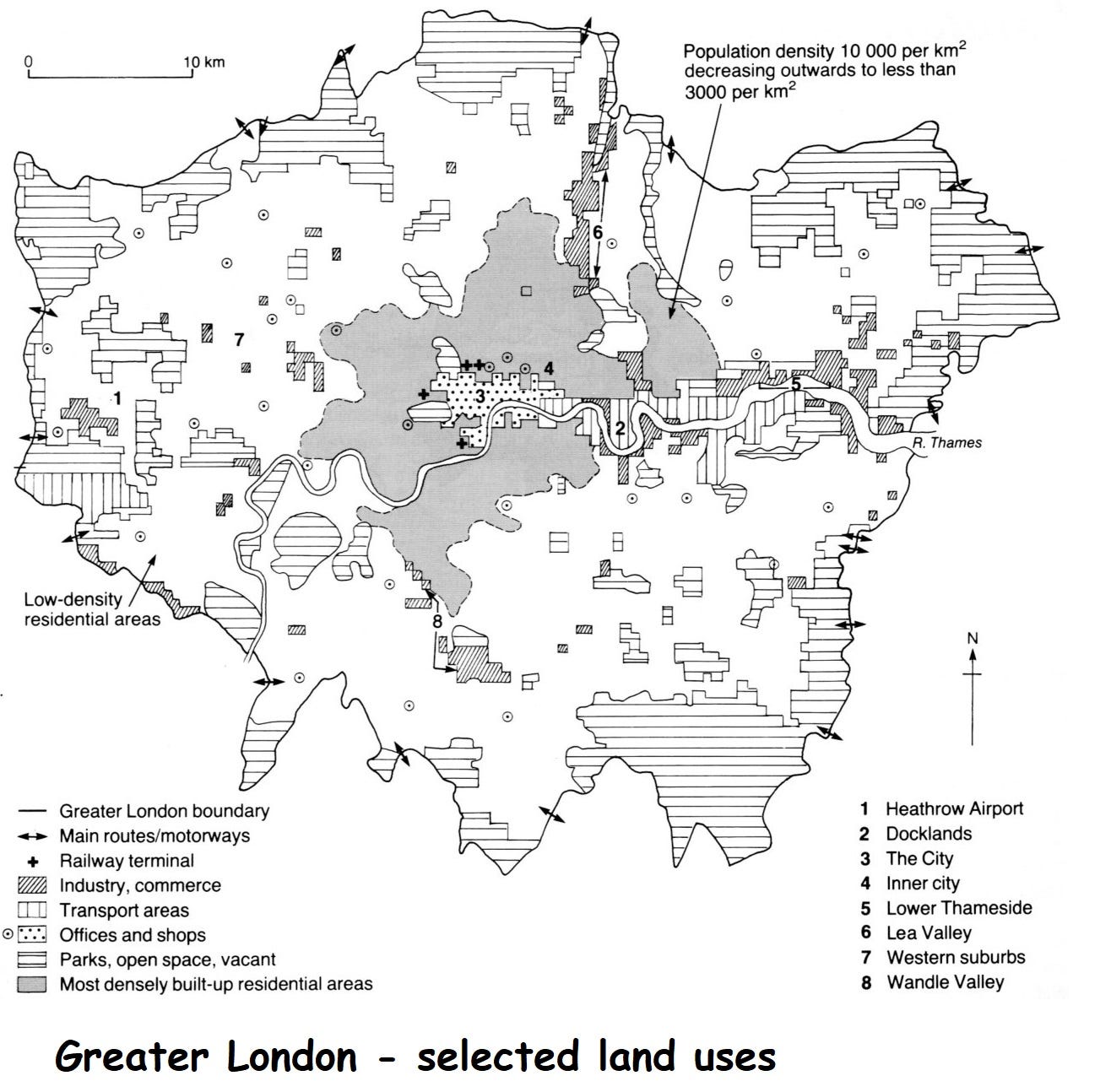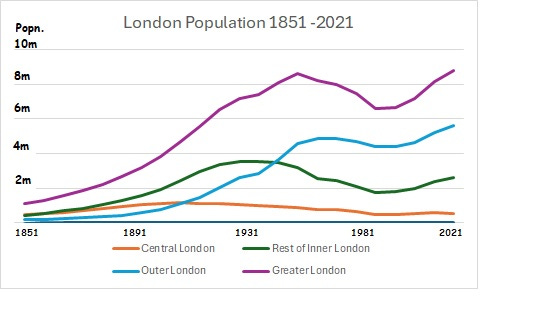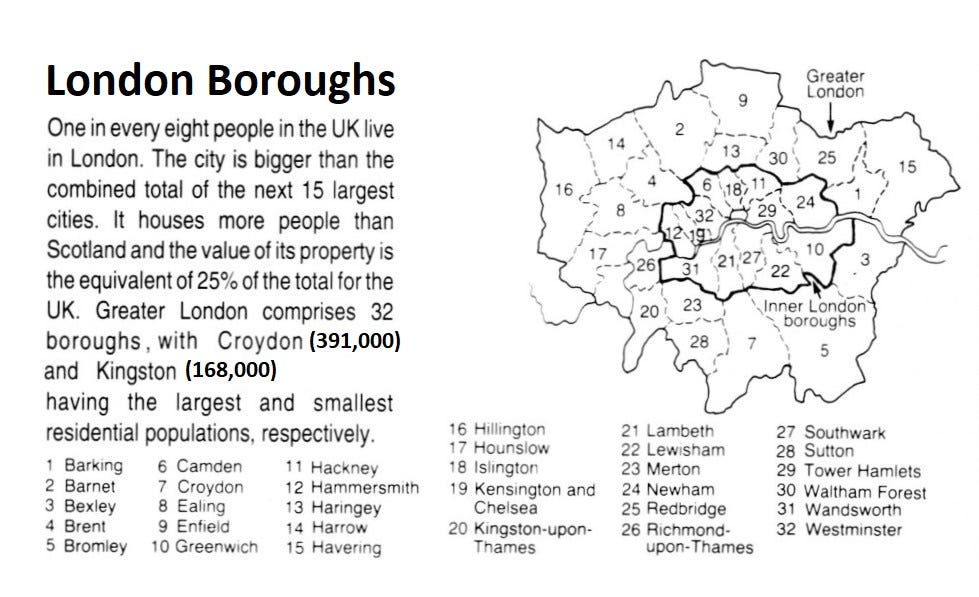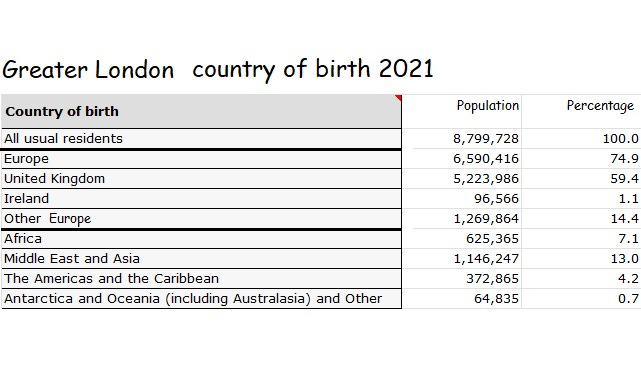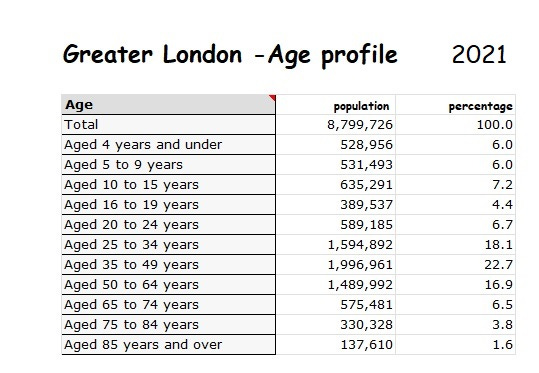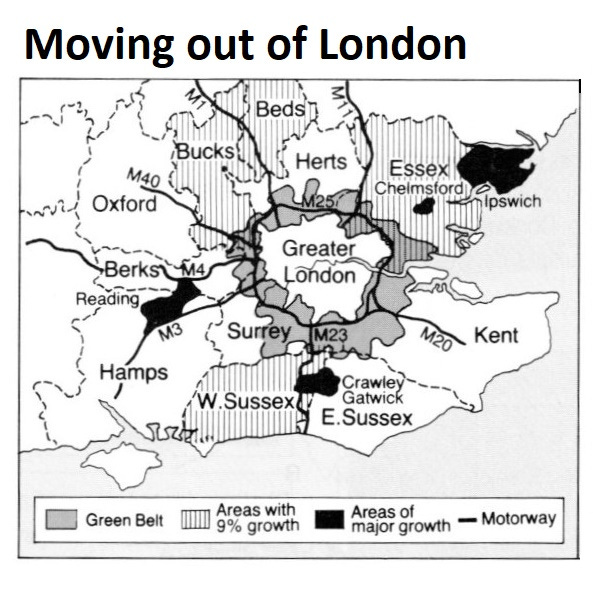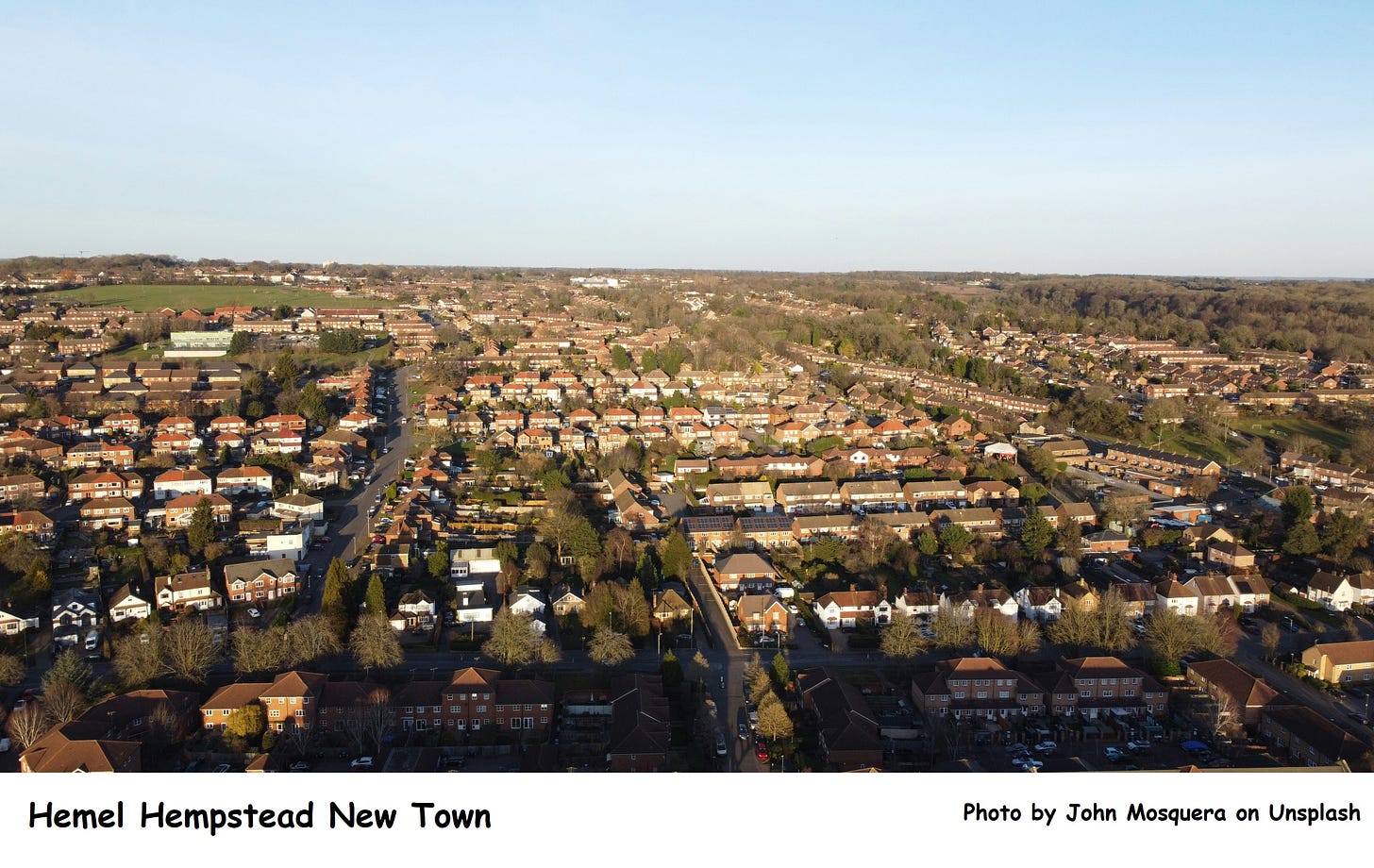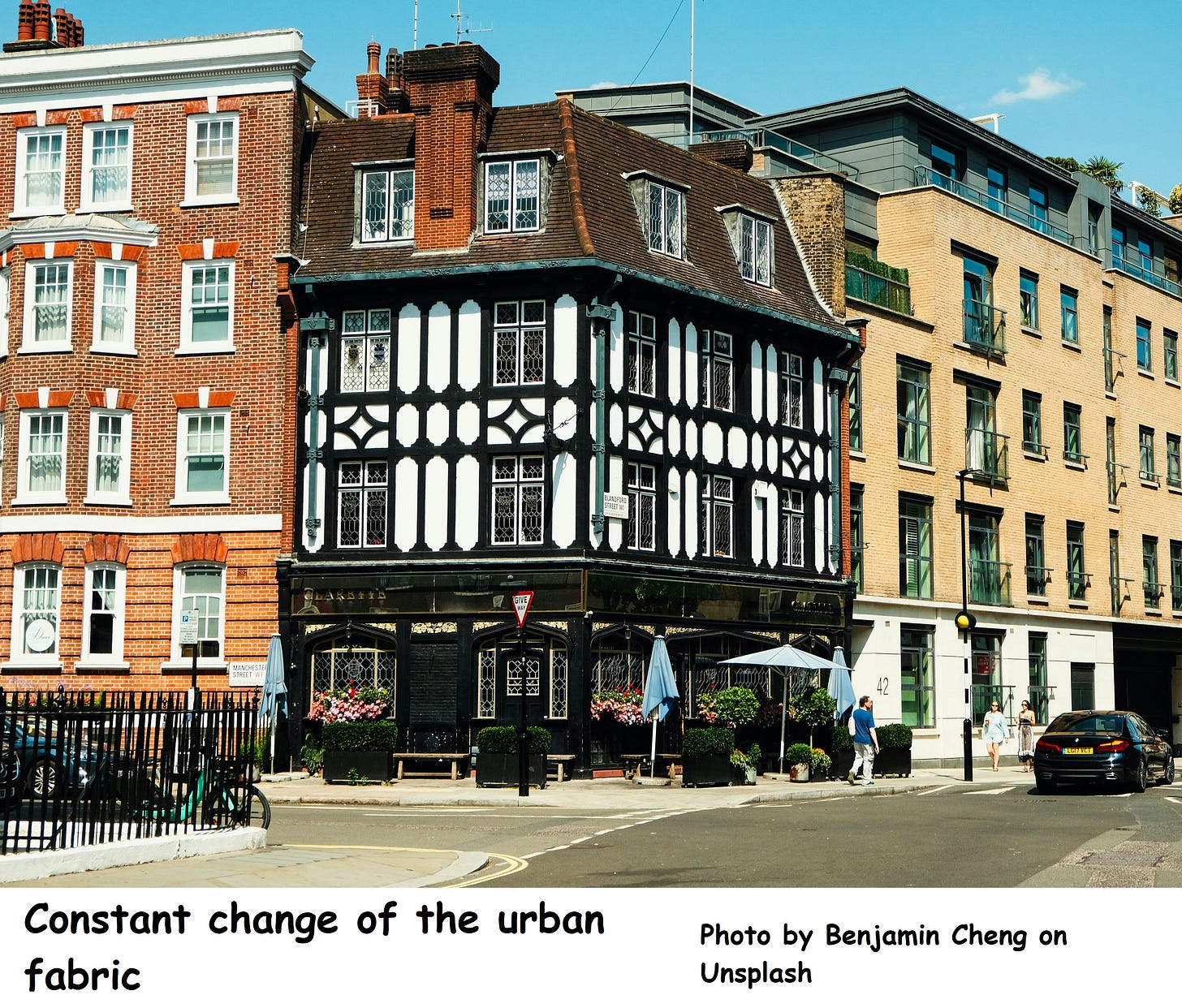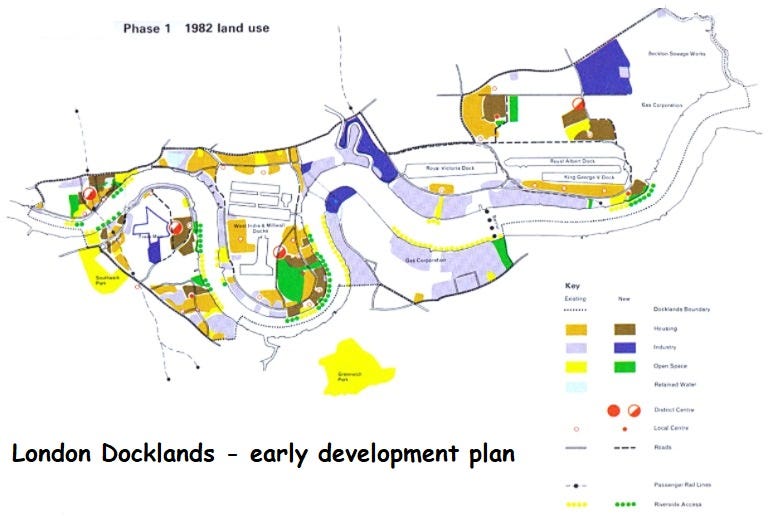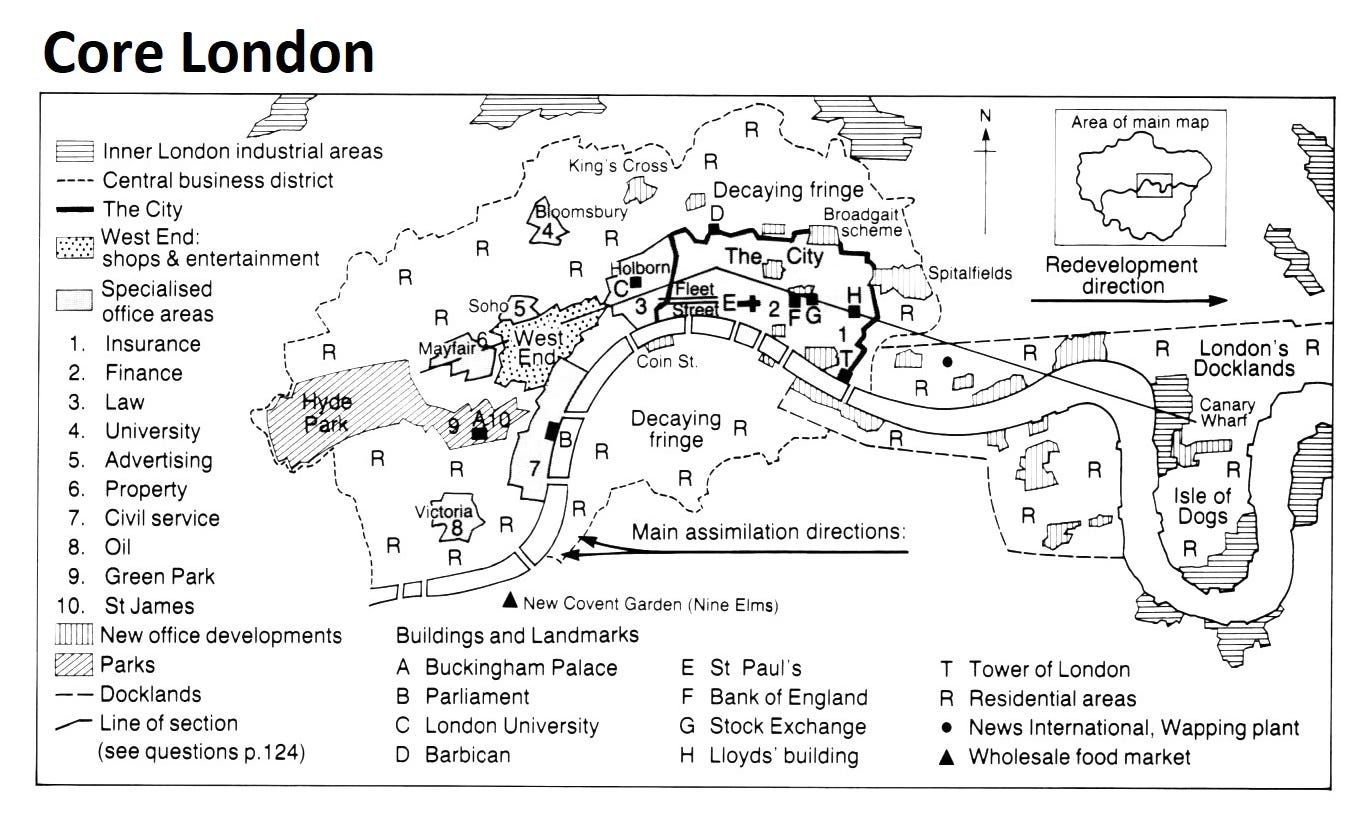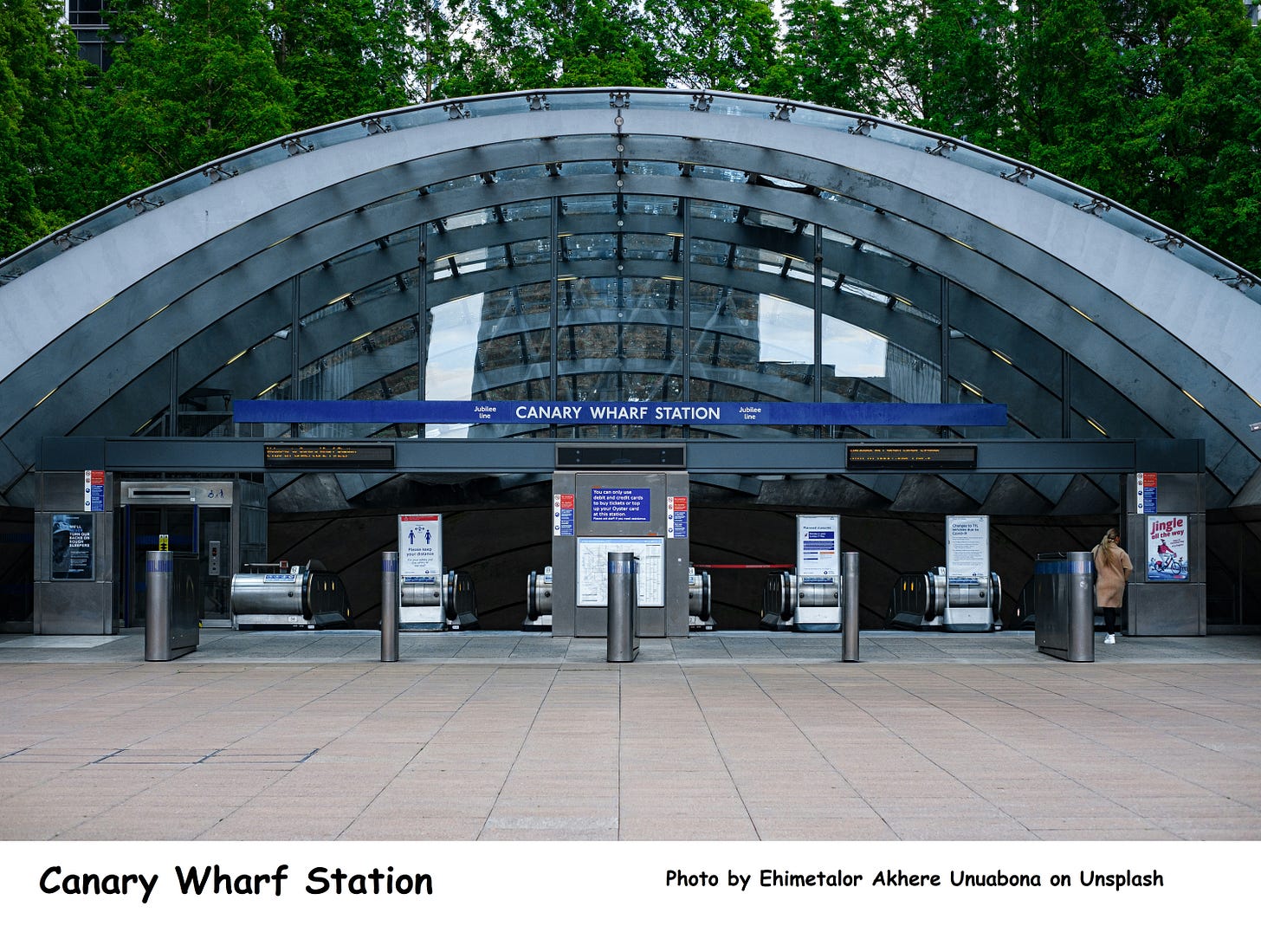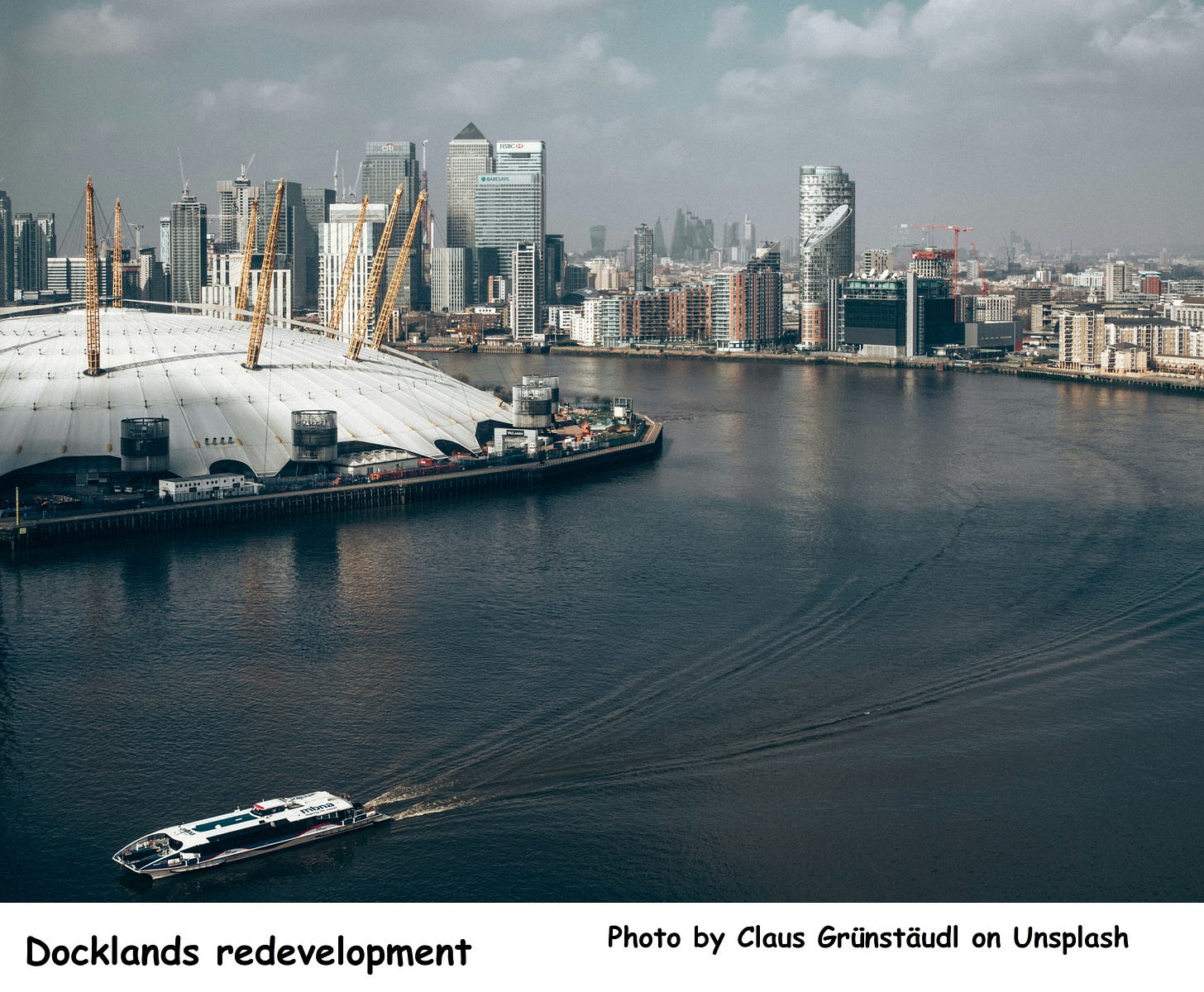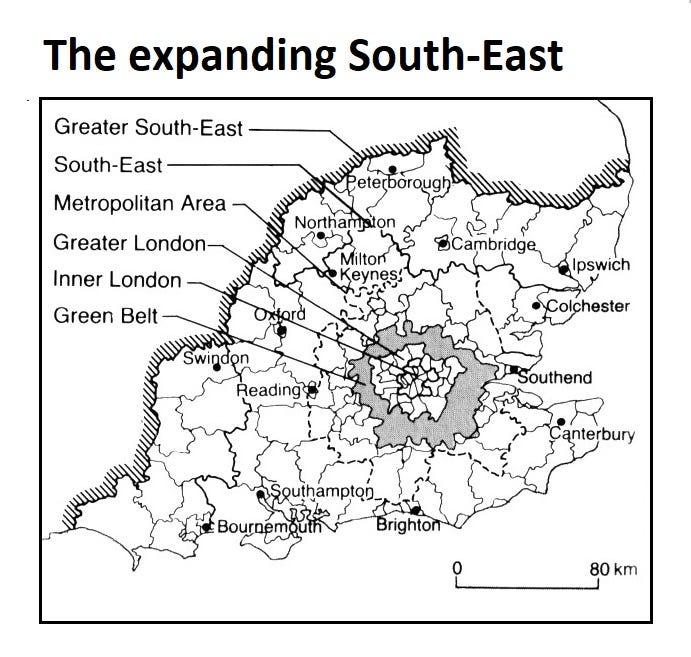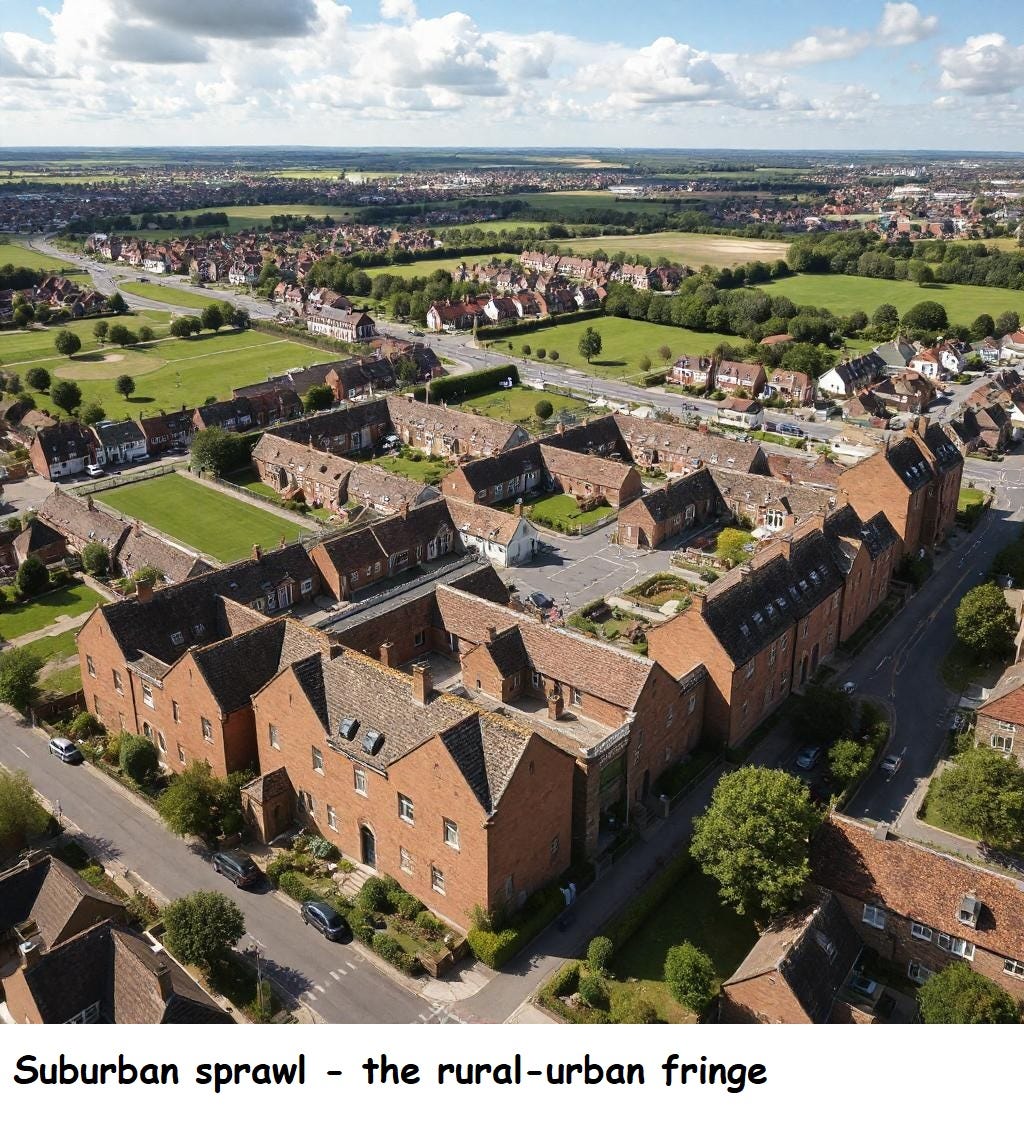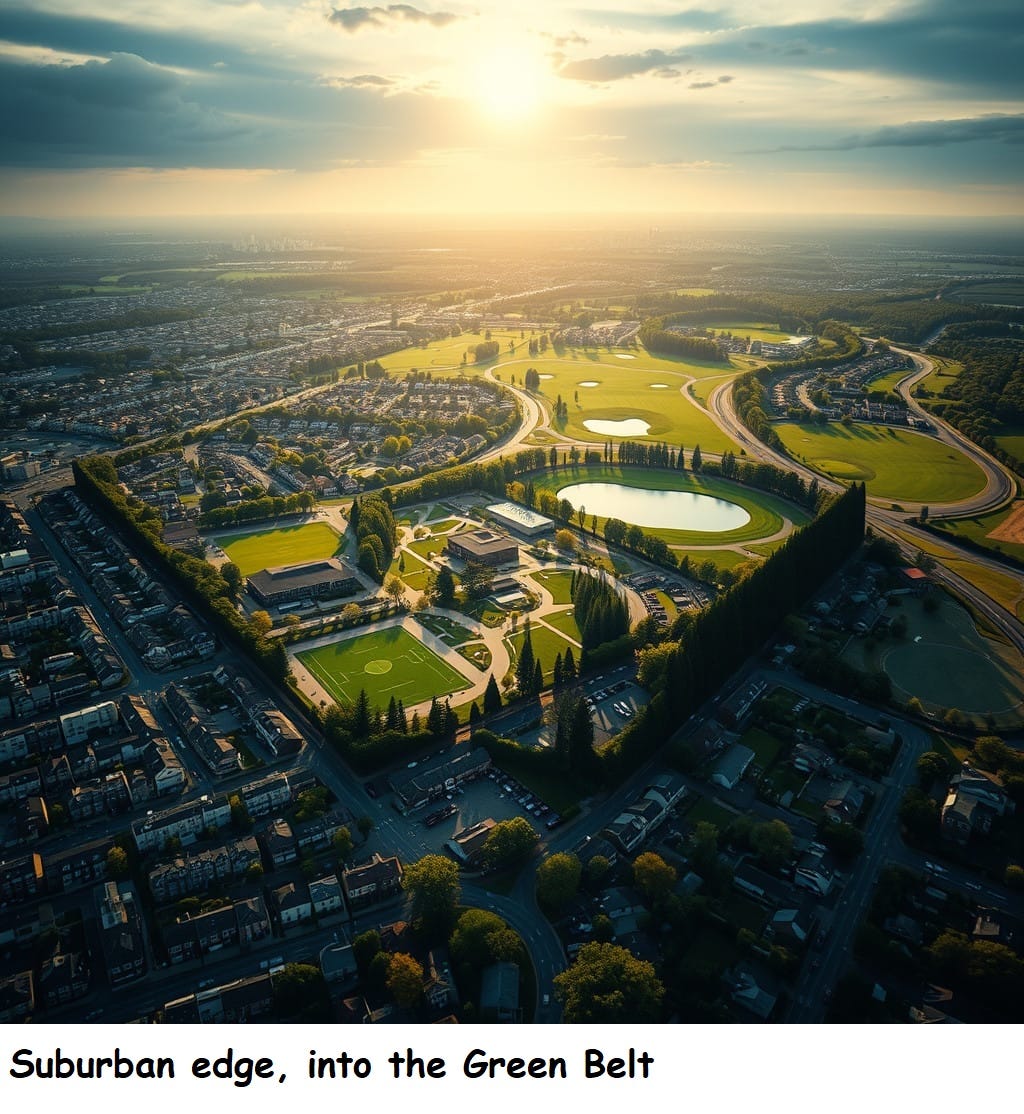(Please note this post is longer than normal and therefore email versions of the post may be truncated. You may need to view it on the Substack app or via this link on your computer. Geography Expert Substack | Ritchie Cunningham | Substack
This post examines London as an example of a large city in a developed country.)
The growth of London since 1851
The growth of London since 1851 has been characterised by significant demographic, economic, and physical changes. During this period, London experienced a substantial increase in population, urban expansion, and transformations in its economic and social landscape. Here is an overview of the key aspects of London's growth since 1851:
Population Growth: London's population witnessed remarkable growth over the past century and a half. In 1851, the population was around 2.6 million, and it grew steadily throughout the late 19th and early 20th centuries. By 1951, the population had reached its peak at around 8.2 million. However, in the mid-20th century, there was a period of suburbanisation, leading to a decline in the city's population. In recent decades, London's population has been on the rise again, fuelled by international migration and natural growth. As of 2021, the population of Greater London surpassed 9 million.
Urban Expansion: London's physical expansion can be traced through the development of suburbs and the annexation of surrounding areas. The city's growth in the 19th century led to the absorption of neighbouring towns and villages into the expanding urban fabric. Notable examples include the incorporation of areas like Croydon, West Ham, and Tottenham into the Greater London area. Suburbanisation and the growth of transportation networks, including railways and later the Underground, facilitated the outward expansion of London. This led to the development of numerous residential suburbs and the creation of a wider metropolitan area.
Economic Transformations: London has undergone significant economic transformations since 1851. The city transitioned from a manufacturing and trading hub in the 19th century to a primarily services-oriented economy in the 20th and 21st centuries. Financial services, banking, insurance, legal services, and the creative industries have become prominent sectors within the city. The growth of Canary Wharf as a major financial district in the 1980s and the subsequent expansion of business and commercial activities in East London have contributed to London's economic evolution.
Infrastructure Development: London has witnessed substantial infrastructure development over the years to support its growth. The construction of iconic landmarks and transportation networks has shaped the city's physical landscape. Notable infrastructure projects include the development of the London Underground, up to the new Elizabeth Line, the expansion and modernisation of railway lines, the construction of bridges such as Tower Bridge and the Millennium Bridge, and the establishment of major airports like Heathrow and Gatwick.
Social and Cultural Shifts: The social and cultural fabric of London has also transformed since 1851. The city has become increasingly diverse, with significant immigration from various parts of the world contributing to its multicultural character. This diversity is reflected in London's vibrant cultural scene, including its music, arts, literature, and culinary offerings. The city has also faced challenges such as urban poverty, inequality, and housing shortages, prompting initiatives to address these issues and create more inclusive communities.
Urban Regeneration: London has witnessed extensive urban regeneration efforts aimed at revitalising and transforming areas within the city. Examples include the regeneration of the Docklands in East London, the redevelopment of King's Cross, and the transformation of former industrial sites into residential and commercial spaces. These initiatives have aimed to enhance the quality of life, create new business opportunities, and improve urban environments.
London's growth since 1851 has been shaped by a complex interplay of economic, social, and physical factors. It has evolved into a global metropolis with a rich history, diverse communities, and a dynamic urban landscape. The city continues to face challenges related to housing, transportation, and social inequality, requiring ongoing planning and investment to ensure sustainable and inclusive growth in the future. London was able to grow rapidly as industrialisation proceeded and eventually a self-reinforcing growth structure developed.
Urban problems have been a result of London's rapid growth
London's rapid growth has brought about several urban problems that the city has grappled with over the years. These challenges arise from the pressure exerted on infrastructure, housing, transportation, and social services due to the increasing population and demands of a global city. Here are some key urban problems resulting from London's rapid growth:
Housing Affordability and Supply: London has faced a severe housing crisis, with skyrocketing property prices and a shortage of affordable housing. The high demand for housing, coupled with limited supply, has led to rising rents, increased homelessness, and difficulties for many residents, particularly those on lower incomes, accessing suitable housing. The affordability crisis has driven the need for increased efforts in affordable housing provision and innovative housing solutions.
Transportation Congestion: The rapid growth of London has put a significant strain on its transportation infrastructure. Traffic congestion, overcrowded public transport, and inadequate transportation links in certain areas have resulted in lengthy commute times, reduced productivity, and increased air pollution. The need for improved transport networks and more sustainable modes of transportation, such as cycling and walking, has become a priority for the city. Congestion charges, ULEZ (ultra-low emission zones) and cycle lanes have all been attempts to improve traffic congestion.
Inequality and Social Exclusion: London's rapid growth has exacerbated social and economic inequalities. The rising cost of living, gentrification, and displacement of lower-income residents have led to the concentration of wealth in certain areas and the marginalisation of disadvantaged communities. The challenge of promoting social inclusion, reducing inequality, and ensuring access to quality education, healthcare, and social services remains a pressing issue.
Environmental Sustainability: The rapid growth of London has placed strains on the city's environmental resources and sustainability. The increased energy consumption, waste generation, and carbon emissions have contributed to environmental degradation and climate change impacts. The city has been working to address these challenges through initiatives focused on sustainable development, renewable energy, waste management, and improving air quality.
Infrastructure and Service Provision: The demand for infrastructure and public services has outpaced the pace of growth in some areas. Issues such as inadequate healthcare facilities, pressure on schools, strained water and sanitation systems, and limited green spaces have emerged as consequences of rapid urbanisation. Investment in infrastructure development and service provision has been critical to meet the needs of the growing population.
Urban Sprawl and Loss of Green Spaces: The expansion of London has resulted in urban sprawl and the loss of green spaces. The conversion of agricultural land and open areas into residential and commercial developments has diminished the availability of green spaces for recreation, biodiversity, and environmental balance. Efforts to protect and enhance green spaces and promote sustainable urban development have become important considerations in urban planning.
Addressing these urban problems requires a comprehensive and integrated approach involving urban planning, housing policies, transportation planning, social initiatives, and environmental sustainability measures. The city has been implementing various strategies and programs to tackle these challenges and create a more sustainable, equitable, and liveable environment for its residents.
The influence of London beyond its boundaries into the southeast of England and beyond
London's influence extends well beyond its boundaries into the Southeast of England and even further afield. This influence can be observed in various aspects, including the economy, transportation, culture, and social dynamics. Here are some key ways in which London's influence radiates beyond its immediate boundaries:
Economic Hub: London serves as the economic powerhouse not just for the city itself but also for the entire Southeast region and the wider UK. The concentration of major financial institutions, multinational corporations, and business services in London creates a significant economic pull. The city acts as a magnet for talent, investment, and innovation, attracting businesses and professionals from surrounding areas. London's economic activities and global connectivity have a substantial ripple effect on the surrounding region, contributing to job creation, trade opportunities, and economic growth.
Commuting and Transportation: London's extensive transportation network, including rail, tube, and bus services, connects the city with surrounding towns and cities. Many residents of the Southeast commute to London for work, benefiting from the employment opportunities the city offers. The transportation infrastructure facilitates the flow of people, goods, and services between London and its neighbouring areas, creating interdependencies and enhancing economic integration.
Housing and Migration: London's high housing costs and limited availability have led to a phenomenon known as "commuter towns." These towns, located in the Southeast region and beyond, provide more affordable housing options for individuals and families who work in London but choose to live outside the city. The housing demand and migration patterns influenced by London's economic opportunities have shaped the demographic composition and development of these commuter towns.
Cultural and Social Influence: London's cultural scene, including its theatres, museums, galleries, and music venues, has a profound impact on the wider region. Many people from the Southeast and other parts of the UK visit London for cultural experiences, contributing to tourism and the economy of the surrounding areas. The city's diverse population and vibrant social scene also influence regional trends and shape the cultural landscape beyond its boundaries.
Education and Research: London boasts world-renowned universities and research institutions. These academic institutions attract students, researchers, and scholars from across the UK and around the globe. The knowledge and expertise generated in London have a spill-over effect, benefiting the wider region through collaborations, knowledge transfer, and the establishment of spin-off industries.
Infrastructure Development: London's infrastructure development projects, such as the expansion of airports, high-speed rail connections, and major road networks, have regional implications. These infrastructure improvements enhance connectivity and accessibility for the Southeast and neighbouring regions, promoting economic growth, trade, and tourism.
Policy and Governance: London's governance structure and policy decisions can have an impact beyond the city itself. Policies implemented in areas such as urban planning, transportation, and economic development can influence neighbouring regions. For instance, decisions related to housing and transportation in London can shape regional planning strategies and investment priorities.
London's influence radiates far beyond its boundaries, making it a regional and global hub that impacts the economic, social, and cultural dynamics of the Southeast of England and beyond. The interdependencies between London and its surrounding areas create a symbiotic relationship, with the city's growth and development driving opportunities and challenges for the wider region.
Population change in inner London and outer London since 1851
The population change in Inner London and Outer London since 1851 has been characterised by significant shifts influenced by various factors, including urbanisation, industrialisation, suburbanisation, and changing patterns of migration. Here is an overview of the population dynamics in Inner London and Outer London over the past two centuries:
Inner London: Inner London, which includes the central boroughs of the city, experienced substantial population growth in the 19th and early 20th centuries. The Industrial Revolution and the growth of manufacturing industries attracted migrants from rural areas and other parts of the country, leading to a rapid increase in population. Inner London's population reached its peak in the mid-20th century.
However, the post-war period witnessed a decline in population as suburbanisation took hold. The availability of new housing developments in the outer areas, improved transportation networks, and a desire for larger homes and green spaces prompted many residents to move away from the crowded and densely populated Inner London. The population decline continued until the 1980s.
Since the 1990s, Inner London has experienced a reversal of population decline. It has become increasingly attractive for young professionals, students, and migrants, drawn by employment opportunities, cultural amenities, and vibrant urban lifestyles. The redevelopment of former industrial areas, gentrification, and the expansion of higher education institutions have contributed to the growth in population. However, the population of Inner London remains lower than its peak in the mid-20th century.
Outer London: Outer London, comprising the boroughs surrounding Inner London, has witnessed substantial population growth over the past two centuries. As industrialisation and suburbanisation took place, workers and families moved to the outskirts of the city in search of more affordable housing and better living conditions. The population of Outer London expanded rapidly throughout the 19th and 20th centuries.
In the mid-20th century, suburbanisation reached its peak as housing developments expanded further into the green belt areas surrounding London. The construction of new towns, the expansion of transportation infrastructure, and the availability of affordable housing attracted a large number of residents to Outer London.
Since the 1980s, the population growth in Outer London has slowed down as available land for development became scarcer. However, it continues to experience steady growth due to factors such as natural population increase, international migration, and the development of brownfield sites. Outer London has also seen a diversification of its population, with increasing ethnic and cultural diversity.
Overall, the population changes in Inner London and Outer London reflect the shifting patterns of urbanisation, industrialisation, and suburbanisation that have shaped the development of the city. While Inner London experienced a population decline followed by a partial recovery, Outer London has seen consistent growth as a result of suburbanisation and the availability of affordable housing options.
Southeast England has grown in population with movement out of London
The areas of Southeast England have experienced significant population growth, largely influenced by the movement of people out of London. This phenomenon is often referred to as suburbanisation or the "London overspill."
New Towns: During the mid-20th century, the British government implemented a program to alleviate housing congestion in London by creating new towns in the surrounding areas. This initiative aimed to decentralise population and economic activities from the capital. Several new towns were established in Southeast England, including Basildon, Harlow, Stevenage, Hemel Hempstead, and Crawley.
These new towns provided affordable housing, improved living conditions, and employment opportunities for Londoners who were seeking to escape the crowded and expensive capital. They were designed with modern infrastructure, amenities, and green spaces to accommodate the influx of population. The establishment of new towns led to a significant population increase in these areas, as people moved out of London to take advantage of the new opportunities.
Suburban Areas: Alongside the development of new towns, existing suburban areas in Southeast England experienced substantial population growth. Towns and villages near London became popular choices for Londoners looking to relocate while maintaining access to the capital for employment or other reasons. Areas such as Surrey, Kent, Essex, Berkshire, and Hertfordshire witnessed significant population increases as people moved out of London and settled in these suburban regions.
The availability of housing, lower costs compared to London, and the desire for a more suburban lifestyle with access to green spaces and better quality of life were among the key factors driving the population growth in these areas. Improved transportation links, such as railway connections and the expansion of road networks, made commuting to London feasible for those who needed to travel to the city for work.
Coastal Areas: Coastal areas in Southeast England also experienced population growth because of migration from London. Places like Brighton, Hastings, Margate, and Eastbourne became popular destinations for those seeking a change of scenery, a seaside lifestyle, or retirement options outside of the city. The availability of affordable housing, coastal amenities, and leisure opportunities attracted Londoners looking to relocate to these coastal towns.
Rural Areas: Even rural areas in Southeast England have seen population growth due to movement out of London. The charm of the countryside, the desire for a slower-paced lifestyle, and the availability of larger properties have enticed some Londoners to move to rural villages and hamlets in the surrounding areas. This trend has brought new life to these rural communities and contributed to their population growth.
The growth of areas in Southeast England through the movement out of London has brought both opportunities and challenges. While it has alleviated population pressures on the capital, it has also led to increased demands on infrastructure, housing, and public services in these suburban and rural areas. Local authorities have had to respond by investing in infrastructure, expanding healthcare and educational facilities, and planning for sustainable development to accommodate the growing population.
Overall, the movement out of London has reshaped the demographic and social landscapes of many areas in Southeast England, leading to significant population growth, economic development, and cultural changes in these regions.
Urban problems facing London in the late 20th century - solutions
In the late 20th century, London faced a range of urban problems, including housing affordability, transportation congestion, environmental concerns, and social inequalities. To address these challenges, various solutions were implemented.
Housing:
a. Affordable Housing Initiatives: The Greater London Council (GLC) and later the Greater London Authority (GLA) implemented policies to promote the provision of affordable housing. This included the introduction of affordable housing quotas in new developments, the establishment of housing associations, and initiatives to refurbish and regenerate existing social housing estates.
b. Urban Renewal and Regeneration: Urban regeneration projects, such as the Docklands regeneration and the development of the Thames Gateway, aimed to provide a mix of housing options, including affordable and high-quality housing, alongside commercial and cultural amenities. These projects transformed former industrial areas into vibrant residential neighbourhoods.
c. Housing Partnerships and Collaborations: Collaboration between public and private sectors, including housing associations, developers, and local authorities, helped to increase the supply of affordable housing. Public-private partnerships were formed to deliver large-scale housing developments and regeneration projects.
Transportation:
a. Public Transport Upgrades: Significant investments were made in improving public transportation systems, including the expansion and modernisation of the London Underground (e.g., Jubilee Line Extension, Elizabeth line) and the development of the Docklands Light Railway (DLR). These enhancements increased the capacity, connectivity, and reliability of public transport services.
b. Congestion Charging: In 2003, London introduced a congestion charge, an innovative approach to reducing traffic congestion and improving air quality in the city centre. Drivers entering the designated zone during peak hours had to pay a fee, encouraging the use of public transport, cycling, and walking.
c. Cycling Infrastructure: Efforts were made to improve cycling infrastructure, including the introduction of dedicated cycle lanes, bike-sharing schemes, and the implementation of the Cycle Hire scheme, known as "Boris Bikes." These initiatives aimed to promote cycling as a sustainable and efficient mode of transport.
Environmental Sustainability:
a. Low-Emission Zones: To tackle air pollution, London introduced low-emission zones, which restricted the entry of high-polluting vehicles into certain areas. These measures aimed to improve air quality and reduce emissions, particularly from diesel vehicles.
b. Green Initiatives: London implemented initiatives to enhance its environmental sustainability, such as increasing green spaces and promoting urban greening projects. Initiatives like the London Green Grid and the creation of new parks and green corridors aimed to improve the quality of life, biodiversity, and climate resilience.
Social Inequalities:
a. Social and Community Programs: The city invested in social programs to address inequalities and promote social cohesion. Initiatives included community-led regeneration projects, social enterprise schemes, and support for grassroots organisations tackling social issues.
b. Affordable Access to Services: Efforts were made to ensure affordable access to healthcare, education, and cultural amenities across different areas of the city. This involved the provision of affordable healthcare facilities, improving educational standards in disadvantaged areas, and supporting cultural initiatives that catered to diverse communities.
c. Community Engagement and Participation: The importance of community involvement in decision-making and urban planning was recognised. Initiatives were introduced to encourage community engagement, such as participatory budgeting, neighbourhood forums, and citizen-led projects.
These solutions were part of a comprehensive approach to address the urban problems facing London in the late 20th century. While some challenges persist, these efforts have helped to improve housing affordability, transportation, environmental sustainability, and social inclusion in the city. Ongoing initiatives continue to tackle emerging urban issues and strive for a more sustainable and equitable London.
The development of the area of London's Docklands since 1980
The development of London's Docklands since 1980 has been a remarkable transformation from a declining industrial area into a thriving business district and desirable residential location. Here is a detailed overview of the key stages and developments that have shaped the Docklands area:
Decline of the Docklands: By the 1960s, the once-thriving London Docklands faced a decline in shipping and industrial activity. The docks became outdated and unable to accommodate larger vessels, leading to their closure and resulting in high unemployment and economic deprivation in the area. The decline continued into the 1970s, exacerbating social and economic challenges.
Government Initiatives: In response to the decline, the UK government launched several initiatives to revitalise the Docklands area and attract investment. The London Docklands Development Corporation (LDDC) was established in 1981 as a regeneration agency with powers to drive redevelopment in the area. The LDDC had a mandate to transform the derelict docks into a vibrant business and residential district.
Infrastructure Development: The first phase of the regeneration effort focused on infrastructure development. The Docklands Light Railway (DLR) was constructed, providing a new light rail system that connected the Docklands area with the rest of London. This transportation infrastructure was crucial in facilitating further development and attracting businesses and residents to the area.
Business Districts: One of the significant achievements of the Docklands regeneration was the development of major business districts. Canary Wharf, located on the Isle of Dogs, became the centrepiece of the Docklands' redevelopment. It transformed into a global financial hub, attracting multinational corporations, banks, and financial institutions. The development of iconic skyscrapers, including One Canada Square, further cemented Canary Wharf's status as a symbol of London's international business prominence.
Residential Transformation: Alongside the business district, the Docklands also saw significant residential development. The construction of new housing, including high-rise apartments and converted warehouse spaces, attracted a mix of professionals, young families, and students. The appeal of riverside living, proximity to the city centre, and the availability of modern amenities drew people to the area.
Cultural and Recreational Enhancements: The Docklands regeneration also focused on cultural and recreational amenities. Historic buildings and warehouses were repurposed as art galleries, museums, and performance venues. The Museum of London Docklands, for example, showcases the area's rich maritime history. Additionally, the development of green spaces, parks, and waterfront promenades provided residents and visitors with recreational opportunities and improved the quality of life in the area.
Continued Expansion and Sustainability: The regeneration of the Docklands has continued beyond the initial phases. The development has extended to areas such as Royal Docks, Greenwich Peninsula, and Stratford, which benefited from the infrastructure and transport improvements associated with the 2012 London Olympics. These areas have seen the construction of new residential neighbourhoods, commercial spaces, and cultural attractions.
Social and Community Initiatives: Efforts were made to ensure that the benefits of regeneration were inclusive and accessible to the local community. Community facilities, schools, and healthcare centres were established, providing essential services to residents. Affordable housing quotas were also introduced to ensure a mix of housing options and prevent the displacement of existing residents.
The development of London's Docklands since 1980 has transformed the area from an industrial wasteland into a vibrant business district, sought-after residential location, and cultural destination. The regeneration efforts have successfully attracted investment, created employment opportunities, improved infrastructure, and revitalised the community. Today, the Docklands stands as a prime example of successful urban regeneration and serves as a testament to the power of strategic planning and investment in transforming post-industrial areas.
The suburban sprawl of London
The suburban sprawl of London refers to the expansion of residential areas beyond the city's central core into the surrounding countryside. This phenomenon has been driven by various factors, including population growth, increased automobile ownership, changing lifestyles, and housing demand. Here is a detailed overview of the suburban sprawl of London:
Early Suburbanisation: The process of suburbanisation began in the 19th century as London's population expanded rapidly due to industrialisation and urbanisation. The availability of railways and improved transportation infrastructure allowed people to live further away from the city centre while still being able to commute to work. Middle-class residents sought larger homes and green spaces, leading to the development of suburban neighbourhoods such as Hampstead, Ealing, and Wimbledon.
Interwar Period: During the interwar period (1918-1939), suburbanisation accelerated due to increased car ownership and improved road networks. The Metropolitan Green Belt, established in 1938, aimed to control the outward expansion of London and preserve the surrounding countryside. However, the Green Belt also contributed to the concentration of development within its boundaries, leading to the growth of suburbs such as Bromley, Croydon, and Enfield.
Post-World War II: After World War II, London experienced a surge in population due to factors such as post-war reconstruction, immigration, and the baby boom. This led to increased demand for housing, prompting the construction of large-scale suburban housing estates. The New Towns program, which aimed to decentralise population and industry from London, resulted in the development of new suburban areas such as Harlow, Stevenage, and Basildon.
Transport Infrastructure: Transportation infrastructure played a crucial role in facilitating suburban sprawl. The expansion of the London Underground, especially in the post-war period, allowed for the extension of suburban lines into previously undeveloped areas. Additionally, the construction of major arterial roads, such as the M25 motorway, improved accessibility and encouraged suburban growth.
Changing Lifestyles and Housing Preferences: Changing lifestyles and housing preferences have also contributed to suburban sprawl. The desire for larger homes, private gardens, and a suburban lifestyle with access to green spaces and amenities has driven people to move away from the city centre. The availability of land for development, particularly on the outskirts of London, has provided opportunities for the construction of new housing estates and suburban neighbourhoods.
Mixed Land Uses: Suburban sprawl in London often includes a mix of land uses, including residential, commercial, and retail spaces. Suburban town centres and retail parks have been developed to serve the growing population and provide convenient shopping and leisure options. However, this mixed land use pattern has also led to increased dependence on cars for transportation, contributing to traffic congestion and environmental concerns.
Challenges and Mitigation: The suburban sprawl of London has presented challenges, including increased pressure on infrastructure, loss of green spaces, and longer commuting distances. Efforts have been made to mitigate these challenges through urban planning, sustainability measures, and the promotion of compact development. Local authorities have focused on creating sustainable communities with well-designed neighbourhoods, improved public transport links, and the protection of green belts and open spaces.
The suburban sprawl of London has transformed the surrounding countryside into a complex mosaic of residential areas, commercial centres, and infrastructure networks. While it has provided housing options and amenities for a growing population, it has also posed challenges in terms of infrastructure provision, environmental impact, and transportation. Balancing the needs of suburban development with sustainability and efficient land use continues to be a crucial aspect of London's urban planning efforts.
The advantages of living in suburbia?
Living in suburbia offers several advantages that attract many individuals and families. Here are some of the key advantages of suburban living:
More Space: Suburban areas typically offer more spacious homes and larger lots compared to urban areas. This extra space allows for bigger yards, gardens, and outdoor living areas, providing residents with more room for relaxation, recreation, and privacy.
Lower Cost of Living: Suburban areas often have a lower cost of living compared to urban centres. Housing prices tend to be more affordable, and the overall cost of goods and services may be lower. This can be especially attractive for individuals or families looking for more affordable housing options or a lower cost of living.
Quieter and Safer Environment: Suburbs generally offer a quieter and less hectic living environment compared to urban areas. There is less traffic, noise pollution, and congestion, allowing for a more peaceful and serene atmosphere. Suburbs often have lower crime rates, contributing to a greater sense of safety and security.
Better Quality of Life: Suburban living is often associated with a higher quality of life. The availability of open spaces, parks, and recreational facilities encourages an active and healthy lifestyle. Suburban neighbourhoods often have well-maintained green spaces, walking trails, and community amenities like swimming pools, playgrounds, and sports fields.
Strong Sense of Community: Suburbs tend to foster a stronger sense of community and neighbourly connections. The close-knit nature of suburban neighbourhoods can lead to more social interactions, community events, and a greater sense of belonging. Residents often form bonds with their neighbours, participate in local activities, and engage in community initiatives.
Access to Good Schools: Suburban areas are frequently known for having well-regarded schools and educational institutions. Families with children may find suburban living appealing due to the availability of quality schools, often with larger campuses and more resources compared to urban schools.
Ample Amenities and Services: While suburbs may not have the same concentration of amenities as urban areas, they often offer a range of essential services, retail centres, shopping malls, and entertainment options. Residents can find convenience in having grocery stores, restaurants, healthcare facilities, and other amenities within close proximity.
Better Air Quality: Suburbs generally have cleaner air quality compared to urban centres due to fewer industrial activities and reduced traffic congestion. This can have positive impacts on overall health and well-being.
It's important to note that the advantages of living in suburbia are subjective and depend on individual preferences, lifestyle choices, and personal circumstances. Some people may prioritise the vibrancy and accessibility of urban living, while others may find the tranquillity and space of suburbia more appealing.
London's Green Belt - how it has influenced urban growth and spread
London's Green Belt is a designated area of open land surrounding the Greater London area, intended to limit urban growth and preserve the countryside. Established in 1938, it covers approximately 514,000 hectares and acts as a buffer zone between London and the surrounding counties. Here is an overview of how London's Green Belt has influenced urban growth and spread:
Controlling Urban Expansion: The primary purpose of the Green Belt is to prevent the unrestricted sprawl of London and contain urban development within defined boundaries. It acts as a physical and visual separation between the city and the countryside, limiting the encroachment of urbanisation into the surrounding areas.
Preservation of Green Spaces: The Green Belt plays a crucial role in preserving and protecting green spaces, natural habitats, farmland, and landscapes around London. It helps maintain the visual character, biodiversity, and ecological balance of the region, providing recreational opportunities and enhancing the overall quality of life for residents.
Promoting Sustainable Development: The Green Belt encourages sustainable development practices by channelling growth into existing urban areas rather than expanding into undeveloped land. It promotes the efficient use of land and resources, protects valuable agricultural land, and helps to reduce urban sprawl and associated environmental impacts.
Managing Population Pressure: London's Green Belt has helped manage population pressure by directing development to designated growth areas within the city and promoting the regeneration of brownfield sites. It has encouraged urban revitalisation and the development of brownfield sites, contributing to the sustainable use of land and infrastructure.
Protecting Rural Economy and Agriculture: The Green Belt supports the agricultural sector by safeguarding farmland and rural areas from urban encroachment. It preserves the viability of agricultural activities, local food production, and rural economies. The agricultural activities within the Green Belt contribute to food security, rural employment, and the preservation of traditional landscapes.
Enhancing Recreation and Access to Nature: The Green Belt provides opportunities for recreational activities, such as walking, cycling, and wildlife watching. It offers a respite from urban life, allowing residents to enjoy the natural environment and access open spaces. Green Belt land often includes parks, nature reserves, and public footpaths, enabling people to connect with nature and enjoy outdoor activities.
Challenges and Tensions: While the Green Belt has played a vital role in managing urban growth, it also poses challenges and tensions. The restrictions on development can contribute to housing shortages, high property prices, and affordability issues in the city. There is an ongoing debate about striking the right balance between protecting the Green Belt and addressing the need for housing and infrastructure development.
In summary, London's Green Belt has been instrumental in controlling urban expansion, preserving green spaces, promoting sustainable development, managing population pressure, protecting agriculture, and enhancing recreational opportunities. It has influenced the growth and spread of London by defining the boundaries of urban development and maintaining the separation between the city and the surrounding countryside.
QUESTIONS
Describe the key demographic changes in London's population since 1851.
Explain the factors that contributed to the urban expansion of London in the 19th and 20th centuries.
Discuss the economic transformations that London has undergone since 1851.
What were the major infrastructure developments in London, and how did they support the city's growth?
Analyse the social and cultural shifts in London since 1851 and their impact on the city's character.
Identify and explain the urban problems that have arisen due to London's rapid growth.
How has London's influence extended beyond its boundaries into the Southeast of England?
Compare and contrast the population changes in Inner London and Outer London since 1851.
What were the solutions implemented to address the urban problems facing London in the late 20th century?
Describe the development of London's Docklands since 1980 and its significance.
Do you agree that London has “Twin” CBDs? Give reasons for your answer.
Outline a case for relaxing the strict enforcement of the Gren Belt around London.
FEEL FREE TO BUY ME A COFFEE IF YOU LIKE MY FREE RESOURCES
or one of my inexpensive books at
Amazon.co.uk: Ritchie Cunningham: books, biography, latest update


